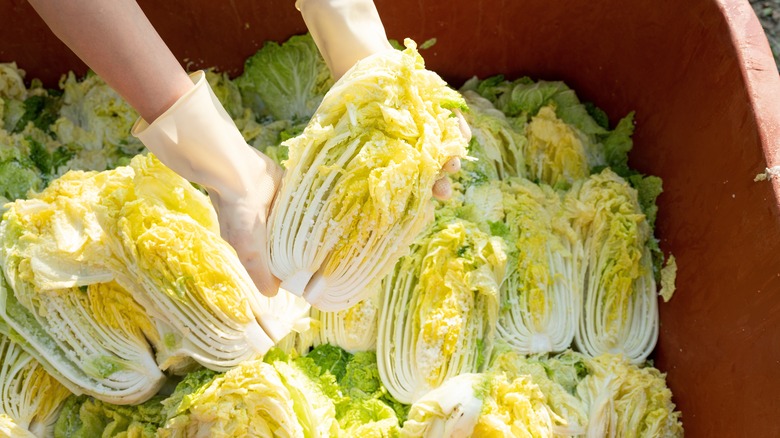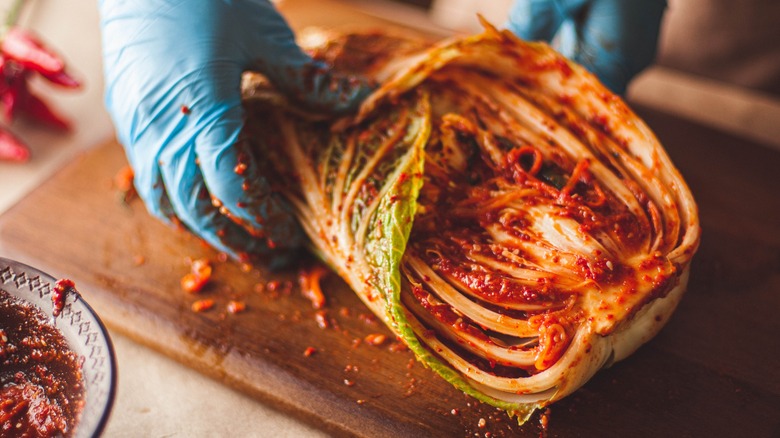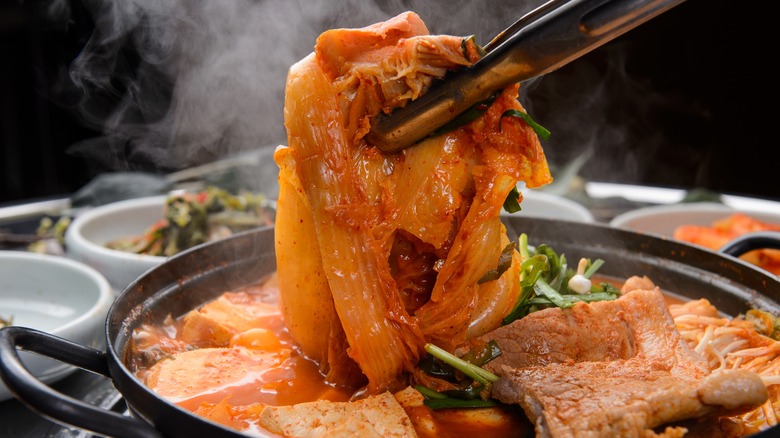Soaking Cabbage Is Crucial When It Comes To Making Kimchi
The term "kimchi" itself refers to a whole family of preserved vegetables, but folks will often hear the word and think of large leaves of fermented Napa cabbage, stained red by Korean pepper flakes called gochugaru, with an unmistakably tangy taste and scent. Napa cabbage kimchi, or baechu kimchi, may look difficult to prepare, but as with many fermented food products, the hardest part of the process is waiting for it to be ready.
One of the most important steps for making kimchi is the preparation of the cabbage leaves themselves. Cabbage leaves contain a lot of water that needs to be extracted or the final fermented product will be much too watery and spoil more easily. How then to remove this water? By adding salt, also known as brining.
An easy way to brine cabbage is by first preparing a brining solution with sea salt and clean, filtered water — many recipes in books and online call for a solution with less than 10% salt. The cabbage leaves are then soaked in the solution between six to 12 hours, where water will leach out of the leaves via osmosis, and the salt penetrates into the leaves in return. There are some folks who prefer a drier brining method by sprinkling salt directly onto the cabbage leaves, but the wet brine solution seasons the cabbage evenly and much more thoroughly. It's important to follow this first step before moving on to the rest of the kimchi-making process.
Other components of kimchi
Other than cabbage, the other ingredients in kimchi-making are the gochugaru slurry (more on that in a moment) and any other vegetables you want to include in the ferment. These vegetables can include daikon radishes, carrots, spring onions, garlic, and ginger. When preparing these vegetables and also the aforementioned cabbage, consider the textures you want in the final ferment. Some people chop the cabbage leaves into roughly two-inch chunks, while others simply quarter a whole head of cabbage and keep each quarter more or less intact. As for the other vegetables, batons or matchsticks are preferred for a good crunch, while ingredients like garlic and ginger should be finely minced so that folks do not get a big bite of the stuff.
The gochugaru slurry is made with rice flour and water, made into a kind of paste that will help carry the main flavor components of the kimchi, namely the gochugaru flakes and fermented shrimp called "saeujeot". Since this fermented shrimp is often the only animal product in the recipe, you can substitute this ingredient with miso for a vegan-friendly alternative. To make your own kimchi, vegan or not, refer to this baechu kimchi recipe as a starting point, which is packed with several tips for the kimchi enthusiast.
Ways to eat and cook with kimchi
Properly prepared kimchi will have enough salt to flavor the rest of the ingredients and to help provide a suitable environment for the vegetables to ferment. As time goes by, you will notice the vegetables releasing even more and more liquid; use the back of a clean ladle to gently submerge the vegetables down into the liquid so that they are not in contact with air.
Now that you have this delicious, worth-the-wait giant jar of kimchi prepared and fermented, there are countless ways to use it up. Eating kimchi straight up with steamed rice is all you really need for a quick meal, though a fried egg would not be unwelcome. Along those lines, it can be served at the table with other dishes and a plain starch like rice or noodles in a family-style meal, its tangy flavor complementing stir fries and soups. Some of the best ways to use kimchi is as an add-in: Think of spicing up mac and cheese, layering it in a burger, and mixing it into fried rice. Kimchi is delicious on fries and nachos as an alternative to the usual toppings. You will run out of kimchi before you run out of ideas!


